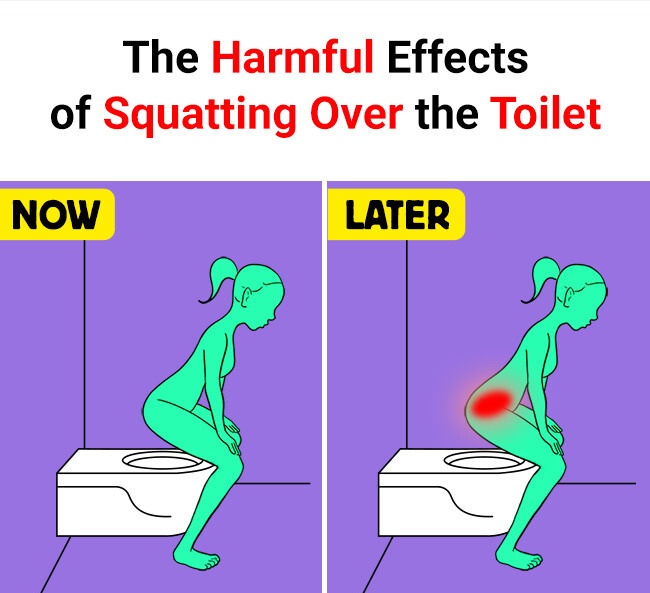Let’s be honest—public restrooms aren’t exactly known for being spotless. When you’re faced with using a less-than-clean toilet, it’s natural to hesitate before sitting down. In fact, many people choose to hover over the seat instead, thinking it’s a more hygienic and safe option. But while hovering might seem like the smart choice, especially in unfamiliar or dirty places, it’s actually a habit that can lead to several unintended health issues, particularly affecting your bladder and pelvic floor.

When you hover or squat over a toilet seat without fully sitting down, your pelvic floor muscles stay partially activated—up to 40% tense—which interferes with their ability to relax. Since these muscles play a crucial role in helping the bladder empty fully, keeping them engaged can prevent complete urination. Over time, this small change in posture can lead to a surprising number of complications. One major issue with hovering is the increased risk of bacterial buildup. When the bladder isn’t emptied completely, the urine that remains can create an ideal environment for bacteria to grow.
This is especially concerning if you make hovering a regular habit. Over time, this can lead to urinary tract infections (UTIs), bladder irritation, and discomfort while urinating. If you often experience that burning sensation or feel like you need to urinate again just moments after finishing, incomplete emptying may be the root cause. That nagging “I still have to pee” feeling isn’t always in your head—it can be a real sign that your bladder didn’t fully release. That constant pressure can be frustrating and lead to more frequent trips to the bathroom, which only reinforces the pattern. Over time, this can condition your body to expect—and attempt—incomplete urination, further aggravating the issue. Another long-term concern involves your pelvic muscles themselves. The repeated act of hovering teaches your body to urinate while partially tense, and over time, that muscle memory can start to backfire.
You may find it more difficult to fully relax when you actually need to empty your bladder, leading to a gradual weakening of bladder control and even increased urgency. The very muscles that should support healthy function are being misused repeatedly, and that can disrupt natural elimination processes in ways that aren’t easy to reverse. If you find yourself uncomfortable with sitting directly on public toilets—an understandable concern—there are better alternatives than hovering. One helpful solution is to carry disposable toilet seat covers or antibacterial wipes with you. These allow you to sit normally without having to worry about germs or mess, helping you maintain both hygiene and healthy pelvic function.
Another alternative that’s even healthier than hovering is the full squat. Not to be confused with the halfway hover, the deep full squat—where your knees are fully bent and you’re closer to the floor—allows the pelvic floor to relax fully and helps the bladder empty more naturally. In fact, cultures that primarily use squat toilets tend to report fewer issues with bladder control and urinary retention, showing that body positioning really does matter. So while it might feel like hovering keeps you clean, it can have unintended consequences that affect how your body functions. Your pelvic floor muscles aren’t meant to stay tense during urination, and forcing them to work that way repeatedly can cause long-term issues. Sitting fully, even in public spaces, is generally the better choice. If you’re concerned about cleanliness, use sanitary products or wipes to feel more at ease. Prioritizing your health in small moments like these can have a big impact in the long run. Remember, the goal is a healthy bladder, strong pelvic muscles, and a relaxed, natural approach to using the restroom. Don’t let fear of germs put your body in a position it wasn’t meant to maintain—literally. Your comfort, health, and well-being are worth more than the brief illusion of cleanliness.





